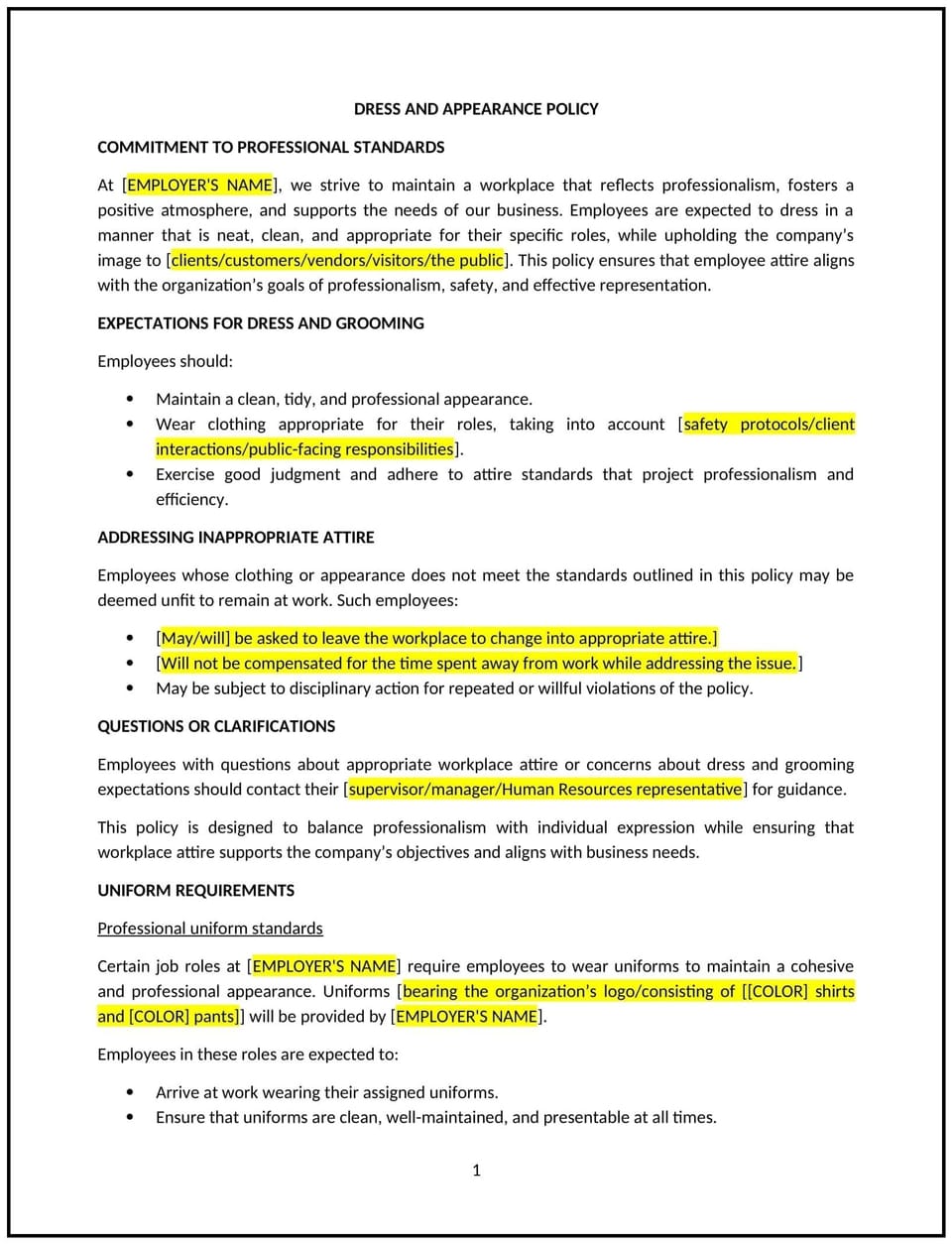Dress and appearance policy (Oregon): Free template

Dress and appearance policy (Oregon)
This dress and appearance policy is designed to help Oregon businesses establish guidelines for employee attire and grooming to maintain a professional workplace. It outlines expectations for dress codes, accommodations for religious or medical needs, and procedures for addressing non-compliance.
By adopting this policy, businesses can promote a professional image, ensure workplace safety, and respect employee individuality.
How to use this dress and appearance policy (Oregon)
- Define dress code requirements: Specify acceptable attire, such as business casual, uniforms, or safety gear.
- Address accommodations: Outline procedures for accommodating religious, medical, or cultural needs related to dress and appearance.
- Set grooming standards: Provide guidelines for personal grooming, such as hygiene and hairstyles.
- Communicate the policy: Share the policy with employees and include it in the employee handbook.
- Train managers: Educate supervisors on enforcing the policy and addressing non-compliance.
- Monitor compliance: Regularly review employee attire and grooming to ensure adherence to the policy.
- Update regularly: Assess the policy annually to align with evolving business needs and societal expectations.
Benefits of using this dress and appearance policy (Oregon)
This policy offers several advantages for Oregon businesses:
- Promotes a professional image: Ensures employees present themselves in a manner that reflects the business’s brand and values.
- Ensures workplace safety: Requires appropriate attire for roles involving physical labor or hazardous environments.
- Respects individuality: Accommodates religious, medical, or cultural needs related to dress and appearance.
- Enhances customer perception: Creates a positive impression on clients and customers.
- Reduces distractions: Maintains a focused and professional work environment.
Tips for using this dress and appearance policy (Oregon)
- Communicate the policy: Share the policy with employees and include it in the employee handbook.
- Provide training: Educate managers on enforcing the policy and addressing non-compliance.
- Be inclusive: Ensure the policy accommodates religious, medical, or cultural needs.
- Monitor compliance: Regularly review employee attire and grooming to ensure adherence to the policy.
- Update regularly: Assess the policy annually to align with evolving business needs and societal expectations.
Q: How does this policy benefit businesses?
A: This policy helps businesses promote a professional image, ensure workplace safety, and respect employee individuality.
Q: Can employees request accommodations for religious attire?
A: Yes, businesses should accommodate religious attire unless it poses an undue hardship.
Q: What should businesses do if an employee violates the dress code?
A: Businesses should address the issue promptly, following the policy’s guidelines and any applicable legal standards.
Q: Are there specific safety requirements for certain roles?
A: Yes, roles involving physical labor or hazardous environments may require specific safety gear, such as helmets or steel-toed boots.
Q: How often should businesses review this policy?
A: Businesses should review the policy annually or as needed to align with evolving business needs and societal expectations.
This article contains general legal information and does not contain legal advice. Cobrief is not a law firm or a substitute for an attorney or law firm. The law is complex and changes often. For legal advice, please ask a lawyer.


